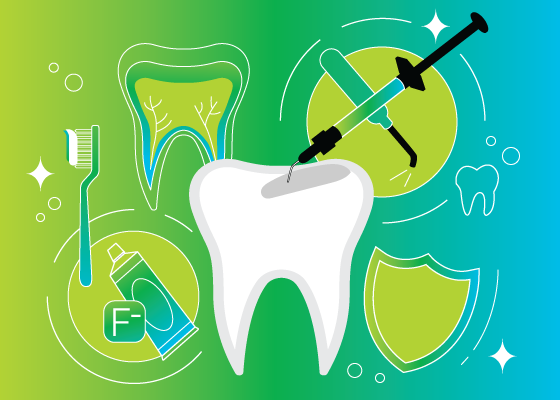Managing caries and motivating change, part 2: Motivational interviewing
How do you motivate your patients? Discover how caries risk assessments and motivational interviewing tactics can help you connect with…


A lot has changed due to COVID-19, including the way we practice. Minimally invasive procedures, such as arresting carious lesions, are gaining momentum. Take a closer look at the changing landscape, and how to make use of these strategies.
The COVID-19 pandemic has brought substantial change to our lives and to our profession. However, it also brought a silver lining to procedures that weren’t widely adopted before the pandemic. As many offices juggle ways to keep their doors open, less invasive procedures – with less aerosol production – have gained momentum.
Here we will discuss two strategies to arrest carious lesions, 1) sealing occlusal non-cavitated lesions, and 2) arresting root caries with 5000ppm toothpaste. It is important to note that these strategies require the highest standard of care – as well as clear communication with your patients, not only of the rationale behind treatment choices but also the results they can expect. Let’s dig into the strategies.
Yes, you can use dental sealants to seal non-cavitated lesions. It may sound odd, considering that sealing over carious lesions is one of the main reasons dental professionals are hesitant to place sealants in the first place, but science says otherwise. For many years, dentists have been trained to either remove tooth decay right away or use the “wait and watch” approach when occlusal fissures or pits look suspicious. However, growing evidence has shown that you can decrease the chances of suspicious lesions advancing further by using a less invasive approach, such as dental sealants.
These lesions are also known as early lesions, incipient lesions or white spot lesions. They present as demineralized areas with changes in color, glossiness or surface structure, without clinical signs of enamel cavitation. Lesions could be limited to enamel only or could extend to dentin. Clinically, this is difficult to distinguish, and x-rays might be needed. Usually lesions appear white, but they can also acquire some pigmentation, making them yellow or brown, or a combination thereof. Fortunately, at this stage, non-cavitated lesions can be arrested either by chemical means, such as with fluorides, or by placing a physical barrier like a sealant.

Sealing over lesions is not new. In fact, there is clinical data going back to the late 1970s. The rationale for sealing a lesion is that a tight seal isolates the caries site and microbial biofilm from the environment. This finding came from observations of how cavitated lesions sealed with a restorative material arrested over time. Now, you might wonder what happens to the bacteria in that lesion – aren’t we leaving infection behind? Studies didn’t find much difference in the bacterial load between sealed and unsealed sites. Furthermore, some sealed lesions had lower levels of microbial load than unsealed lesions. In other words, bacteria didn’t proliferate under the sealants, as the bacteria died or went dormant due to nutrient starvation.
In line with this, the most up to date guidelines by the American Dental Association (ADA) and the American Association of Pediatric Dentistry (AAPD) recommend the use of sealants to arrest non-cavitated lesions. The seal is the deal to avoid caries progression!

Let’s take a look at how to successfully translate this approach into clinical practice:
There are several factors that contribute to the low level of sealant utilization in dental practices. The first is a lack of awareness of the growing body of evidence supporting their indication for caries arrest, which shows that sealants are effective at both preventing and arresting non-cavitated caries lesions in primary and permanent molars.
Insurance in the U.S. is another important limiting factor for widespread adoption and treatment acceptance. As clinicians, we need to explain the long-term benefits of doing less invasive procedures and how they play into keeping our patients healthy. If a lesion progresses due to lack of intervention, that tooth will need a more invasive restoration – which comes with a higher cost, both economically and biologically.
This is an underutilized weapon that has become more relevant during the pandemic. According to the 2018 non-restorative clinical guidelines by the ADA, the use of a 5000ppm toothpaste is the recommended approach to arrest root caries, whether they are non-cavitated or cavitated. Armed with this information, you have a convenient way to help keep your patients’ caries under control and avoid progression.
Several countries, including the U.S., are experiencing a change in demographics with a growing segment of the elderly population that is retaining teeth longer than previous generations. This has also been accompanied by a higher prevalence of root caries, most likely due to a combination of increased gingival recession and dry mouth. This is an ugly mixture of factors that facilitate rapid onset and progression of root caries if left without proper intervention.
Recently, the ADA appraised evidence from clinical trials on root caries arrest using a variety of interventions. The expert panel suggested that clinicians prioritize the daily use of 5,000ppm fluoride (1.1% NaF) toothpaste or gel over other interventions. Since it is more difficult to clinically distinguish if root caries is cavitated, they recommend the approach to be taken in both cases. Read the full report here.
The amount of evidence to date is still limited but several factors can be mentioned:
In summary, the use of sealants and 5000ppm toothpaste for caries arrest allows for the implementation of minimally invasive strategies to keep our patients healthy. Keep in mind that for any therapy to succeed, educating patients on their oral health condition and treatment is critical, and must go hand in hand with good care at home. During this pandemic, our communication should, at a minimum, include recommendations for brushing twice a day with fluoride toothpaste and interdental cleaning at least once a day, as well as eating a healthy diet that limits sugary snacks between meals. This level of communication extends our services and oral health support beyond the walls of our clinics. These efforts, along with less invasive strategies, will help us move forward through the pandemic and into future – towards better oral health for all.
Sources

How do you motivate your patients? Discover how caries risk assessments and motivational interviewing tactics can help you connect with…

Caries is a complicated multifactorial disease. In this two-part series, explore how caries risk assessments can help improve evaluation and…

Zirconia may be part of your everyday vocabulary, but how much do you know about this ceramic material? Learn more…